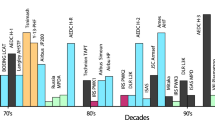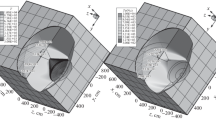Abstract
Space vehicles mowing through the high atmosphere are usually exposed to a hypersonic rarefied flow. In addition to the flow field rarefaction the high flight velocities impose severe problems on the flow field development and on the necessary simulation facilities. Vehicles, which strong influence of rarefaction effects on flight performance or on their design are
-
Satellites in low orbit
-
Aeroassisted orbit transfer vehicles (AOTV)
-
Reentry vehicles.
Access this chapter
Tax calculation will be finalised at checkout
Purchases are for personal use only
Preview
Unable to display preview. Download preview PDF.
Similar content being viewed by others
Abbreviations
- A:
-
reference area
- Cp :
-
pressure coefficient
- D:
-
diameter
- D:
-
drag
- Ė:
-
energy flux
- h:
-
specific enthalpy
- hd :
-
specific enthalpy for dissociation
- Kn:
-
Knudsen number
- Kr :
-
rate constant for specific reaction
- l:
-
body length
- lchar :
-
characteristic flow field length
- lr :
-
reaction length
- L:
-
nozzle length
- M:
-
molecular mass (kg/K mol)
- Ma:
-
Mach number
- m:
-
mass flow
- n:
-
number density of molecules
- p:
-
pressure
- q:
-
dynamic pressure
- q:
-
heat flux
- Q:
-
heat flow
- r:
-
recovery factor
- r:
-
radius of curvature
- Re:
-
Reynolds number
- Rs :
-
similarity parameter for a chemical reaction
- S:
-
molecular speed ratio
- T:
-
temperature
- V:
-
magnitude of celocity vector
- v:
-
volume flow (equal suction speed S)
- u,v,w,:
-
velocity components
- x,y,z:
-
local rectangular coordinates
- δ:
-
boundary layer thickness
- ө:
-
nozzle half angle
- κ:
-
ratio of specific heats
- λ:
-
molecular mean free path
- μ:
-
viscosity
- v :
-
molecular collision frequency
- c:
-
continuum
- FM:
-
free molecular
- i:
-
incident molecules
- n:
-
mormal component to surface
- r:
-
reflected molecules
- s:
-
stagnation point on a body
- t:
-
total conditions with isentropic compression
- w:
-
wall
- O:
-
stagnation chamber conditions
- s:
-
stagnation point on a body
- 1:
-
test section conditions, free stream
- 2:
-
condition behind a normal shock wave
- ∞:
-
free stream
- *:
-
distance from nozzle throat
References
Kogan, M.N., Rarefied Gas Dynamics, New York: Plenum Press, 1969.
Vincenti, W.G., Kruger, H.C., Introduction to Physical Gas Dynamics. New York: John Wiley, 1967
Freeman, Nonequilibrium Flow of an Ideal Dissociating Gas. J. Fluid Mech., Vol.4, 1958, pp. 401–424.
Harney, D.J., Chemical Kinetic Regimes of Hypersonic Flight Simulation. AEDS-TDR-63–3, 1963
Hornung, H., 28th Lanchester Memorial Lecture, Experimental Real- Gas Hypersonics., ZFW 12 (1988), pp 293–301
Daum, F.L., Gyarmathy, G., Condensation of Air and Nitrogen in Hypersonic Wind Tunnels. AIAA Journal, 1968, pp.458–465
Dankert, C., Koppenwaliner, G., Homogeneous Condensation in N2, Ar, and H2O Free Jets. J. Phys. Chemistry, 91, 1987 pp. 2482–2486.
Vas, I., Koppenwaliner, G., The Princeton University High Pressure Hypersonic Nitrogen Tunnel N-3. Princeton University, Gas Dynamics Laboratory, Rep. 690, 1964
Harvey, J.K., Jeffery, R.W., Uppington, D.C., The Imperial College Graphite Heated Hypersonic Wind Tunnel. R & M, No. 3701, Ministry of Defence Aeronautical Research Council Reports and Memoranda, London, 1972
Wuest, W., Koppenwallner, G., Hefer, G., Legge, H., Der hypersonische Vakuumkanal der Aerodynamischen Versuchsanstalt Gottingen. Jahrbuch 1969 der DGLR, pp.38–52.
Allegre, J., Raffin, M., Obtention de nombres de Mach compris entre 15 et 30 dans une sufflerie a fonctionnement continu. L. Aeronautique et L’ Astronautique, No.37, 1972 pp. 67–79
Shreeve, R.P., Lord, W.T., Boersen, S.J., Bogdonoff, S.M., A Graphite Resistance Heater for a Hypersonic Wind Tunnel Using Nitrogen. Part I: Description of Tunnel and Heater. Part II: Analysis of Heater Performance. Int. J. Heat Mass Transfer, 5, 1962, pp. 1081–1103.
Potter, J.L., Kinslow, M., Arney, G.D., Bailey, A.B., Description and Preliminary Calibration of a Low Density Hypervelocity Wind Tunnel. AEDC-TN 61–63, 1961.
Fiebig, M., Kindler, K., Papanikas, G., Hochleistungsbrenner und Expansionsdüsen zur Untersuchung von Hochenthalpiestro-mungen. DLR-Mitt. 75–06, 1975.
Maslach, G.J., Sherman, F.S., Design and Testing of an Axi-symmetric Nozzle for a Low Density Wind Tunnel, WADS-TR-56–34–341, University of California, Report 150–134, 1956.
Vas, I.E., Allegre, J., The N-4 Hypersonic Low Density Facility and Some Premilinary Results on a Sharp Flat Plate. Rarefied Gas Dynamics, Vol. II, 1967, pp. 1015–1030. Proc. 5th Int. Symposium. New York: Academic Press, 1967.
Hefer, G., Kienappel, K., Erprobung einer mit Stickstoff gekühlten Düse des Hypersonischen Vakuumwindkanals. DLR-FB 70–41, 1970.
Ashkenas, H., Sherman, F.S., The Structure and Ultilization of Supersonic Free Jets on Low-Density Wind Tunnels. Proceedings of the 4th Int. Symposium on Rarefied Gas Dynamics, Toronto, 1964 (ed. J.H. de Leeuw), Vol. II, pp. 84–105, New York: Academic Press, 1966.
Bisch, Ch., Etude de jets libres et de jets emis an culot d’un cylindre place dans un ecoulement hypersonique. Aeronautique et l’Astronautia ve No. 63, pp. 31–41, 1977–2.
Christ, S., Sherman, D.M., Glas, D.R., Study of the Highly Underexpanded Sonic Jet. AIAA Journal, Vol. 4, 1966, pp. 68–71.
Allegre, J., Private Communication.
Lighthill, M.J., Dynamics of a dissociating gas, Part I Equilibrium Flow., J. Fluid Mech. Vol.2 1957, pp 1–32
Stollery, J.L., Park, C., Computer solutions to the problem of vibrational relaxation in hypersonic nozzle flow. J. Fluid Mech. Vol.19, 1964, pp 113–123
Bray K.N.C, Atomic recombination in a hypersonic wind tunnel nozzle., J. Fluid Mech. Vol.6, 1959, pp 1–32
Koppenwallner G., Review of Flow Quality obtained in Conical and Contoured Nozzles of Hypersonic High Enthalpy Wind Tunnels. (Vibrational Relaxation). DFVLR IB 222–88 A 33, 1988
Anonym, Handbook of Supersonic Aerodynamics, Section 17, Ducts, Nozzles and Diffusors. NAVWEPS-Report 1488, Vol 6, U.S. Government Printing, 1964.
Allegre, J., Raffin, M., Etude experimentelle d’un diffuseur en ecoulement hypersonic de gaz rarefie. Lab. d’Aerothermique, Paris, Rep. 68–4, 1968.
Koppenwallner, G., Der hypersonische Vakuumwindkanal der Aerodynamischen Versuchsanstalt Göttingen. Betriebsverhalten und erste Ergebnisse über reale Gaseffekte in Düsenströmungen. DLR-FB 66–62, 1966.
Anonym, ARC heaters and MHD accelerators for aerodynamic purposes. AGARDograph 84, 1964
Boatright, W.B. et alea, Summary of some of the Arc Heated Hypersonic Windtunnel Development Effort underway at the Langley Research Center. AGARDograph 84, 1964, pp 353–378
Auweter-Kurz et alea, Steady State MPD Devices for Reentry Simulation., DGLR/AIAA/JSASS International Propulsion Conference, Garmisch Partenkirchen, W.Germany 1988
French, J.B., Molecular Beams for Rarefied Gas Dynamic Research. AGAR-Dograph 112, 1966.
Bossel U. Erzeugung intensiver Molekularstrahlen suborbitaler Energien fur Streuexperimente. DLR- FB 72–52, 1972
Kantrowitz, A., A High Intensity Source for the Molecular Beam. Rev. of Scientific Instruments, Vol. 22, May 1955, pp. 328–332.
Bossel U. Molecular beam Extraction from Equilibrium gas Flow., AIAA J. Vol.9 1971, pp 2060–2062
Campargue R., Lebehot A., High intensity supersonic molecular beams with Extremely narrow energy spread. Rarefied Gas Dynamics. Proc. 9th Int. Symposium, DFVLR Press 1974
Knuth, E.L. Kiuluva, N.M. Performance of an Arc- Heated Supersonic Molecular Beam and its Application to Molecule-Molecule Collisions. AGARD CP 12 (1967) pp 277–338
Stark J.P.W, Kinnerslay M.A., Development of a Low Power, High Velocity Atomic Oxygen Source. in Rarefied Gas Dynamics, Edited by E.P. Muntz et alea. Vol. 116 Progress in Astronautics and Aeronautics 1989, pp 156–170.
Skinner, G.T., On the design of experiments with a Shock tube Driven Molecular Beam. AGARD CP-12 pp 423–441
Jones T.V., Experiments on the Formatiuon of a 2 eV Argon Beam from a Shock Tube Source, Rarefied Gas Dynamics, Proc. 5th Symposium, Academic Press 1967, pp 377–409. 09.
Cross, J.B., Blais N.C., High -Energy/Intensity CW Atomic Oxygen Beam Source., in Rarefied Gas Dynamics, Edited by E.P. Muntz et alea. Vol. 116 Progress in Astronautics and Aeronautics 1989, pp 143–154..
Abuaf, N., Anderson, J.B., Andres, R.P., Molecular beams with Energies above one Electrn Volt. Science, 155 (1967), 997–999
Abuaf, N., Anderson, J.B., Andres, R.P., Studies of Low Density Supersonic Jets, in Rarefied Gas Dynamics, Proc. 5th Symposium, Academic Press 1967, pp 1317–1336
Sjolander G.W., Froechtenicht J.F., Laboratory Results for 5-ev Oxygen Atoms on Selected Spacecraft Materials. in Rarefied Gas Dynamics, Edited by E.P. Muntz et alea. Vol. 116 Progress in Astronautics and Aeronautics; 1989, pp 180–179.
Moser H.O. Investigation of the influence of low density gas atmospheres on spacecraft by means of accelerated cluster ion beam, Z. Flugwiss. Weltraumforsch., 11 (1987) pp 291–294
Dankert, C., Legge, H., High Intensity Molecular Beams Skimmed in Continuum Flow. Rarefied Gas Dynamics, Vol, 74, pp. 882–894. Progress in Astronautics and Aeronautics, 1981; ed. S. Fisher.
Author information
Authors and Affiliations
Editor information
Editors and Affiliations
Rights and permissions
Copyright information
© 1992 Springer Science+Business Media New York
About this chapter
Cite this chapter
Koppenwallner, G. (1992). Low Density Facilities. In: Bertin, J.J., Periaux, J., Ballmann, J. (eds) Advances in Hypersonics. Birkhäuser, Boston, MA. https://doi.org/10.1007/978-1-4612-0379-7_6
Download citation
DOI: https://doi.org/10.1007/978-1-4612-0379-7_6
Publisher Name: Birkhäuser, Boston, MA
Print ISBN: 978-1-4612-6734-8
Online ISBN: 978-1-4612-0379-7
eBook Packages: Springer Book Archive




